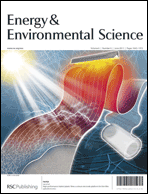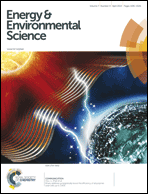We are delighted to announce a big rise in the Impact Factor* of Energy & Environmental Science (EES) to a new high of 11.65.

We sincerely thank all our authors and referees for your continuing support that has made this possible – Energy & Environmental Science is your journal.
This great news demonstrates the journal continues to attract and publish outstanding, community-spanning, agenda-setting research. We have even higher aspirations for the future, and welcome your suggestions, feedback and ideas at any time.
To celebrate, we would like to share with you some of the great reviews and original research articles recently published in Energy & Environmental Science.
You can read these articles for free for a limited period by clicking on the links below.
Reviews and Analysis
Semiconductor nanowires: a platform for exploring limits and concepts for nano-enabled solar cells
Thomas J. Kempa, Robert W. Day, Sun-Kyung Kim, Hong-Gyu Park and Charles M. Lieber
DOI: 10.1039/C3EE24182C
Catalysis for CO2 conversion: a key technology for rapid introduction of renewable energy in the value chain of chemical industries
Gabriele Centi, Elsje Alessandra Quadrelli and Siglinda Perathoner
DOI: 10.1039/C3EE00056G
Reliable evaluation of dye-sensitized solar cells
Xudong Yang, Masatoshi Yanagida and Liyuan Han
DOI: 10.1039/C2EE22998F
Plasmonic solar water splitting
Scott C. Warren and Elijah Thimsen
DOI: 10.1039/C1EE02875H
Solar cells with one-day energy payback for the factories of the future
Nieves Espinosa, Markus Hösel, Dechan Angmo and Frederik C. Krebs
DOI: 10.1039/C1EE02728J
Perspectives on thermoelectrics: from fundamentals to device applications
M. Zebarjadi, K. Esfarjani, M. S. Dresselhaus, Z. F. Ren and G. Chen
DOI: 10.1039/C1EE02497C
Na-ion batteries, recent advances and present challenges to become low cost energy storage systems
Verónica Palomares, Paula Serras, Irune Villaluenga, Karina B. Hueso, Javier Carretero-González and Teófilo Rojo
DOI: 10.1039/C2EE02781J
3D carbon based nanostructures for advanced supercapacitors
Hao Jiang, Pooi See Lee and Chunzhong Li
DOI: 10.1039/C2EE23284G
Photoelectrochemical cells for solar hydrogen production: current state of promising photoelectrodes, methods to improve their properties, and outlook
Zhaosheng Li, Wenjun Luo, Minglong Zhang, Jianyong Feng and Zhigang Zou
DOI: 10.1039/C2EE22618A
Towards high-performance polymer-based thermoelectric materials
Ming He, Feng Qiu and Zhiqun Lin
DOI: 10.1039/C3EE24193A
Bio-inspired artificial light-harvesting antennas for enhancement of solar energy capture in dye-sensitized solar cells
Fabrice Odobel, Yann Pellegrin and Julien Warnan
DOI: 10.1039/C3EE24229C
Original Research
Harnessing the open-circuit voltage via a new series of Ru(II) sensitizers bearing (iso-)quinolinyl pyrazolate ancillaries
Kuan-Lin Wu, Wan-Ping Ku, John N. Clifford, Emilio Palomares, Shu-Te Ho, Yun Chi, Shih-Hung Liu, Pi-Tai Chou, Mohammad K. Nazeeruddin and Michael Grätzel
DOI: 10.1039/C2EE23988D
Highly sensitive stretchable transparent piezoelectric nanogenerators
Ju-Hyuck Lee, Keun Young Lee, Brijesh Kumar, Nguyen Thanh Tien, Nae-Eung Lee and Sang-Woo Kim
DOI: 10.1039/C2EE23530G
Biomass-derived electrocatalytic composites for hydrogen evolution
Wei-Fu Chen, Shilpa Iyer, Shweta Iyer, Kotaro Sasaki, Chiu-Hui Wang, Yimei Zhu, James T. Muckerman and Etsuko Fujita
DOI: 10.1039/C3EE40596F
Periodic heating amplifies the efficiency of thermoelectric energy conversion
Yan Yan and Jonathan A. Malen
DOI: 10.1039/C3EE24158K
Low-temperature processed meso-superstructured to thin-film perovskite solar cells
James M. Ball, Michael M. Lee, Andrew Hey and Henry J. Snaith
DOI: 10.1039/C3EE40810H
A facile approach for the synthesis of monolithic hierarchical porous carbons – high performance materials for amine based CO2 capture and supercapacitor electrode
Luis Estevez, Rubal Dua, Nidhi Bhandari, Anirudh Ramanujapuram, Peng Wang and Emmanuel P. Giannelis
DOI: 10.1039/C3EE40549D
Transparent and conductive paper from nanocellulose fibers
Liangbing Hu, Guangyuan Zheng, Jie Yao, Nian Liu, Ben Weil, Martin Eskilsson, Erdem Karabulut, Zhichao Ruan, Shanhui Fan, Jason T. Bloking, Michael D. McGehee, Lars Wågberg and Yi Cui
DOI: 10.1039/C2EE23635D
Assembling carbon-coated α-Fe2O3 hollow nanohorns on the CNT backbone for superior lithium storage capability
Zhiyu Wang, Deyan Luan, Srinivasan Madhavi, Yong Hu and Xiong Wen (David) Lou
DOI: 10.1039/C1EE02831F
From “cyborg” lobsters to a pacemaker powered by implantable biofuel cells
Kevin MacVittie, Jan Halámek, Lenka Halámková, Mark Southcott, William D. Jemison, Robert Lobel and Evgeny Katz
DOI: 10.1039/C2EE23209J
Li–S batteries: simple approaches for superior performance
Rezan Demir-Cakan, Mathieu Morcrette, Gangulibabu, Aurélie Guéguen, Rémi Dedryvère and Jean-Marie Tarascon
DOI: 10.1039/C2EE23411D
Sr- and Mn-doped LaAlO3-δ for Solar Thermochemical H2 and CO Production
Anthony H. McDaniel, Elizabeth C. Miller, Darwin Arifin, Andrea Ambrosini, Eric Coker, Ryan O’Hayre, William Chueh and Jianhua Tong
DOI: 10.1039/C3EE41372A
Hybrid Energy Cell for Self-Powered Water Splitting
Ya Yang, Hulin Zhang, Zong-Hong Lin, Yan Liu, Jun Chen, Ziyin Lin, Yusheng Zhou, C P Wong and Zhonglin Wang
DOI: 10.1039/C3EE41485J
Please do continue to submit your best work to Energy & Environmental Science. We look forward to further success in the months and years ahead.
To keep up to date with our news visit our website, or follow us on Facebook and Twitter:
Sign up to receive our free table-of-contents e-alert at http://www.rsc.org/alerts and be among the first to read our newest articles.
*The Impact Factor provides an indication of the average number of citations per paper. Produced annually, Impact Factors are calculated by dividing the number of citations in a year by the number of citeable articles published in the preceding two years. Data based on 2012 Journal Citation Reports®, (Thomson Reuters, 2013).














